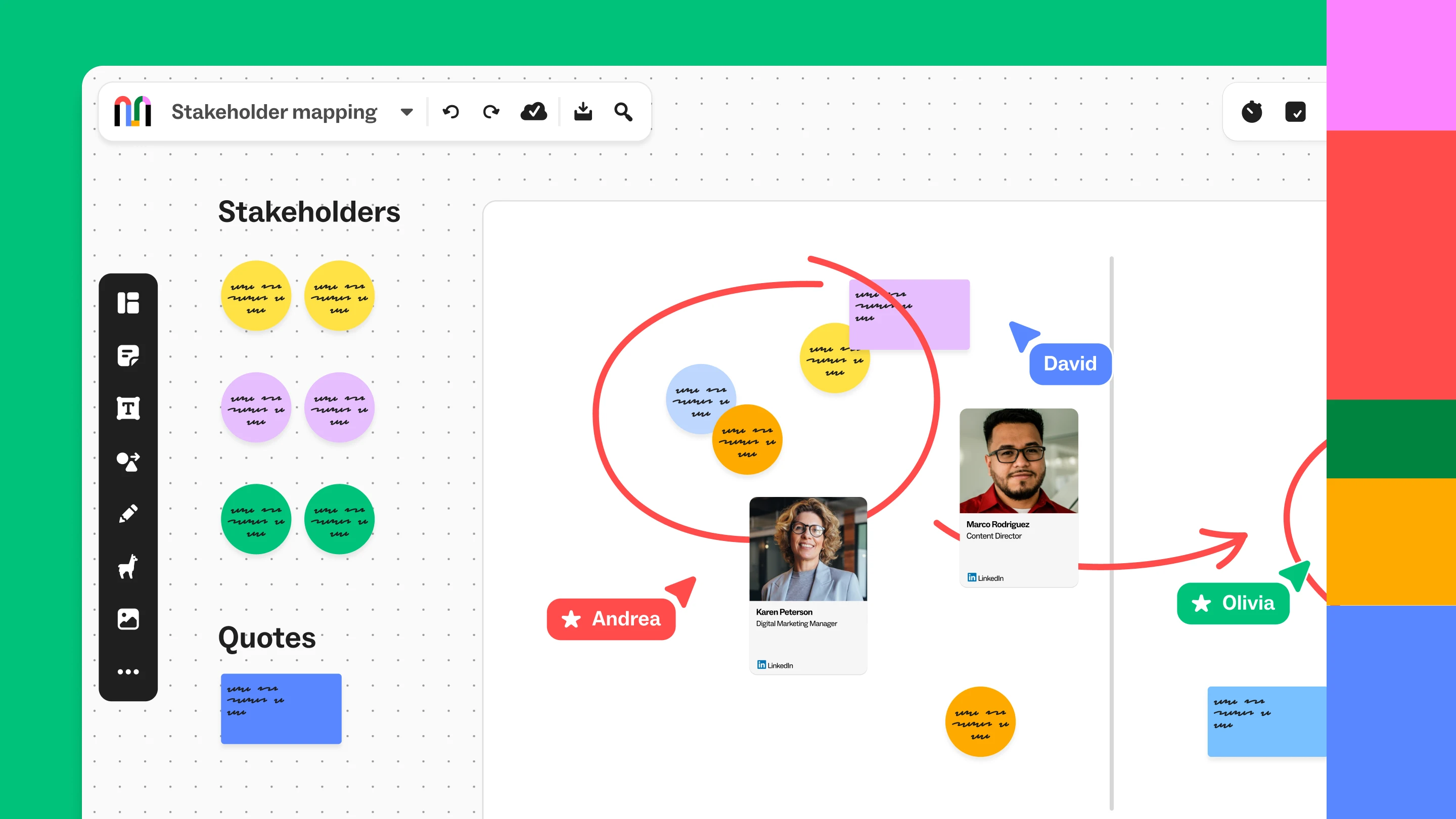When working cross-functionally, stakeholder management is critical for any project’s success. No matter the industry or initiative, stakeholders can make or break a project, and their expectations play a crucial role in determining project outcomes.
That’s why it’s key to get buy-in from the beginning, and be transparent throughout the process, to stay aligned and on target as a team.
In this article, we’ll share ten practical tips for managing stakeholder expectations, along with templates to help you strengthen alignment and accelerate outcomes.
Why is it important to manage stakeholder expectations?
Stakeholders are the people or groups with a vested interest in your project’s outcome. Because they can influence decisions, resources, timelines, and success criteria, your ability to understand and manage their expectations is directly tied to your project’s success.
Stakeholders generally fall into one of four main categories:
- Primary stakeholders (e.g., employees, customers) have a direct impact.
- Secondary stakeholders (e.g., shareholders) have an indirect impact.
- Tertiary stakeholders (e.g., industry experts) may have a potential impact.
- Quaternary stakeholders (e.g., the media) may be interested in the project’s success or failure.
It’s essential to consider all of these stakeholders when creating a successful product or project. Managing expectations is important because it helps to make sure everyone understands the project’s goals, size, and requirements.
Common challenges in stakeholder management
Stakeholder management comes with its own set of challenges, and some of the common ones include:
- Identifying all project stakeholders and their interests
- Understanding and managing conflicting stakeholder interests
- Addressing the varying levels of stakeholder engagement and interest
- Managing stakeholder expectations that can change over time
- Communicating with stakeholders who have different levels of technical knowledge and understanding
- Balancing the competing demands of stakeholders
10 tips for effective stakeholder expectation management
1. Identify your stakeholders
The first step in effective stakeholder management is to identify all stakeholders and their interests. It’s important to know who they are, what they care about, and how they are likely to respond to your project.
Tip: Brainstorming with a cross-functional team can be the best way to identify all key stakeholders, taking into account different perspectives and outcomes that may affect a broad range of personas.
2. Understand stakeholder needs and expectations
Once you have identified your stakeholders, you need to understand their needs and expectations. This will help you tailor your approach to suit each stakeholder group.
Ask questions like:
- What does success look like to them?
- What risks or blockers concern them?
- How do they prefer to communicate?
- How invested are they in day-to-day progress?
- Mapping these motivations helps you tailor communications and prevent future misalignment.
3. Create a stakeholder analysis
A stakeholder analysis is helps you clarify:
- Who your stakeholders are
- How much influence they have
- What their expectations are
- How frequently and deeply you should engage them
Using the results from your brainstorming session and refinements to understand stakeholder needs and expectations, you can build a stakeholder analysis using a template to divide stakeholders visually into one of the four quadrants (primary, secondary, tertiary, quaternary) based on their level of influence.
For teams in complex product development, explore AI-powered stakeholder mapping for R&D teams to visualize your innovation network and make confident, focused decisions.
4. Develop a stakeholder engagement plan
Your engagement plan should define:
- Who you communicate with
- What you communicate
- How frequently you communicate
- Which channels you use
- How decisions are documented
This reduces the risk of miscommunication and gives stakeholders confidence in your process.
Ready to get started? Check out our guide on creating better stakeholder engagement plans.
5. Set realistic expectations
Consistency and clarity build trust with stakeholders as you prove your reliability over time. Make sure everyone understands:
- What will be delivered
- By when
- What constraints exist
- What assumptions you’re working under
- How change requests will be handled
Avoid over-promising. Stakeholders respect consistency more than ambition without follow-through.
6. Open a channel of communication
Create an open channel of communication that allows stakeholders to voice their concerns, ask questions, and get updates on the project’s progress.
Collecting regular feedback from stakeholders can help identify any blind spots you may have, improve alignment with stakeholders, and lead to greater innovation.
7. Conduct regular check-ins
Different stakeholders need different cadences, but the principle stands: Stay connected.
This can include:
- Weekly or bi-weekly status updates
- Monthly steering meetings
- Async progress recaps
- Milestone presentations
The goal: keep everyone informed and eliminate unnecessary uncertainty.
8. Be consistent in the tools you use to manage stakeholder engagement
Consistency is essential in stakeholder engagement. You should use the same tools to communicate with your stakeholders to avoid confusion and provide a consistent experience.
Having a shared digital space like a mural, where you plan and track progress, can not only help ensure alignment on goals and outcomes, but also streamline communication by giving every stakeholder a single source of truth that evolves along with your project.
9. Check in after key meetings
Following up after meetings with a summary of meeting notes and action items is crucial to ensure that stakeholders understand their responsibilities and next steps. After every major discussion:
- Summarize decisions
- Identify owners
- Capture next steps
- Clarity timelines
Written follow-ups prevent misinterpretation and help stakeholders stay accountable.
10. Measure and report progress
Measuring and reporting progress helps to demonstrate the project success and identify areas for improvement.
Metrics could include:
- Milestone completions
- Scope changes
- Timeline risks
- Resource usage
- Key results progress
Metrics also support continuous improvement for future projects.
5 templates for managing stakeholder expectations
1. Project north star template

The project north star template aligns project goals, roles, target audience, and other essential details for effective and efficient team collaboration. Use it for new projects, pitches, or client requests.
2. Visualize the vote template

Democratizing the decision-making process prevents any single voice or idea from taking precedence. Instead, everyone is encouraged to be judicious in order to find the favored option. One useful tool for gathering everyone's input is visualize the vote, which allows each person to indicate their preferences and opinions before final decisions are made.
3. Stakeholder mapping template

This stakeholder mapping template minimizes confusion regarding roles and responsibilities — use this template to identify stakeholders and strategize for their level of involvement in the project. Explore our blog on stakeholder mapping for sales, for a deeper dive.
4. Problem tree analysis template
.png)
The problem tree analysis template maps causes and effects to understand the circumstances that led to the current situation. The tree metaphor separates causes (roots) from effects (branches) of a central issue (trunk). This structured approach helps teams reveal concerns, discern causes from symptoms, and frame problem statements better.
5. Buy a feature template

This buy a feature template simulates real-life budgeting scenarios and helps identify which features or concepts are most important. By providing a limited amount of currency for purchasing items, participants must prioritize their choices. The decision-making process can be monitored by asking questions about why certain choices were made, providing valuable insights into the design process.
More to explore
Mural offers dozens of free, editable templates to help you better understand stakeholder needs, align teams, and make confident decisions faster.
The bottom line: Take stakeholder management to a new level
Effective stakeholder management isn’t a one-time exercise. It’s an ongoing practice of clarity, alignment, and communication. By identifying stakeholders early, understanding their needs, and keeping communication open and consistent, your team can build trust, reduce friction, and deliver outcomes everyone believes in.



![How to create a stakeholder map [templates & examples]](https://cdn.prod.website-files.com/63062129119620a44791a2eb/68c86139fdfa85df67976919_689f47a2691857ea61eb39a8_stakeholder_mapping_hero_image_1440x810_2x.webp)









